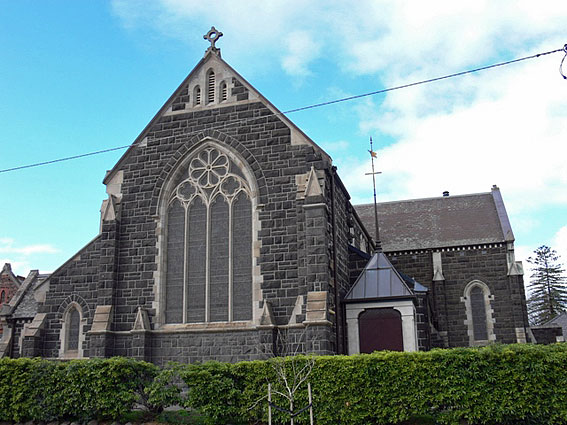
St Columb’s Anglican Church, Hawthorn – exterior
[photograph by John Maidment (August 2008)]
Historical and Technical Documentation by John Maidment
© OHTA, August 2008 (last updated November 2021)

St Columb’s Anglican Church, Hawthorn – exterior
[photograph by John Maidment (August 2008)]
Historical and Technical Documentation by John Maidment
© OHTA, August 2008 (last updated November 2021)
St Columb’s Church was designed by George Wharton and built 1882-83 in bluestone with freestone dressings in the Decorated Gothic style. The building was completed in 1907 by architects H.W. & F.B. Tompkins, but without the intended tower and spire to the south-west.1 It remains substantially unaltered and retains many of its original fittings including carved woodwork and stained glass by William Montgomery, Alan Sumner and others.
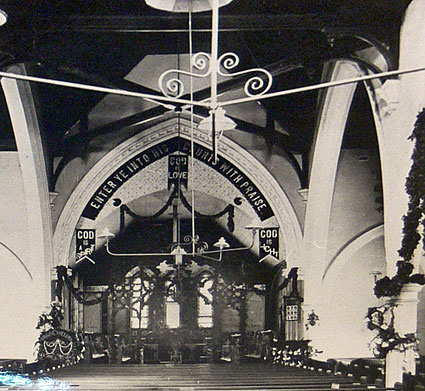
St Columb’s Anglican Church, Hawthorn: interior before chancel extension, with William Stone organ to the left
[photograph before 1907 from collection of John Maidment, ex St Columb’s archives]
The first pipe organ was built by William Stone, of St Kilda. It cost £250 and was opened on 23 November 1884.2 This instrument was placed in a chamber on the left hand side of the temporary chancel and had a case with two outer towers and a central flat very similar to the 1879 Stone organ now at The Avenue Church, Blackburn, Victoria. It was sold in 1923 to St Andrew’s Presbyterian Church, Murwillumbah, NSW where it still remains, following a rebuild by Whitehouse Bros. in 1954.
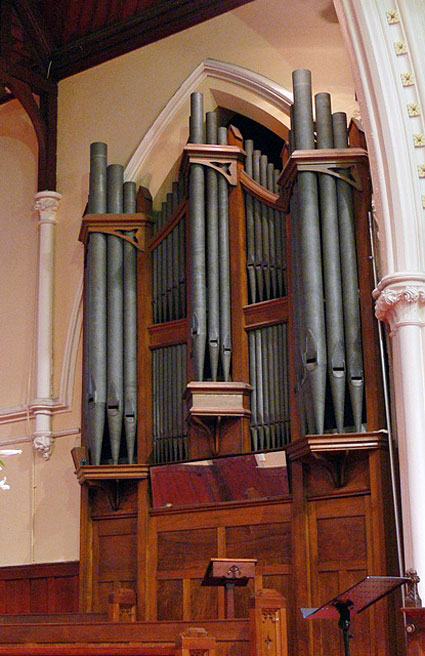
St Columb’s Anglican Church, Hawthorn: chancel case of the 1923 Roberts organ
[photograph by John Maidment (August 2008)]
The present organ was built by Roberts Ltd, of Melbourne and Adelaide, and was dedicated on Sunday 30 September 1923 – the firm’s opus number 98.3 It is placed in an organ chamber on the south side of the chancel, with an arch facing into the south transept, both filled with unpainted zinc pipes (those facing the transept, made by Sam Potter, of Hawthorn, are non-speaking). The blower is placed in an external chamber.
It was reported:
The organ consists of two manuals of 61 notes each, and a pedal clavier of 32 notes. The draw stops are on the stop key principle, arranged over the top row of keys. The main organ has eight stops, the swell organ 11, and the pedal organ five, while there are eight couplers. The case which is carved in bold Gothic architecture, in Manchurian oak, consists of three towers of five pipes each, and two bays, each containing two layers of pipes. To meet the indifferent acoustics of the church the scaling of the various stops has been specially designed. The organ is blown by an electric motor with a four-stage blower. This fine instrument ranks among the great organs of Melbourne. Its cost was £1,800 the whole sum was raised by voluntary subscription.4
The organ was designed by Arthur Nickson FRCO, organist of St Peter’s Church, Eastern Hill and Melbourne Grammar School. Roberts also built organs for All Saints’ Church, East St Kilda, St Andrew’s Church, Brighton, Christ Church, Essendon, All Saints’, Kooyong and elsewhere in Melbourne. The St Columb’s organ is of considerable historical and musical significance as it is now the largest Roberts organ to remain tonally unaltered.
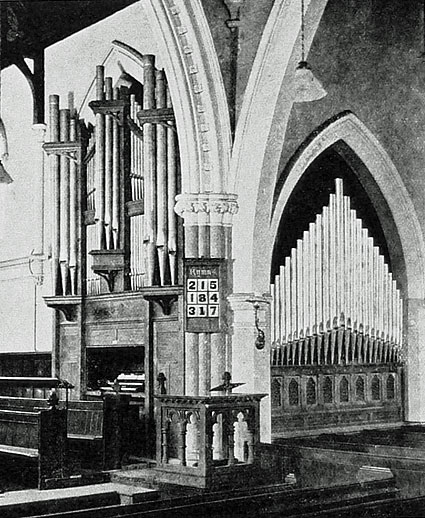
St Columb’s Anglican Church, Hawthorn: organ as shown in contemporary Roberts brochure
[from collection of David Shield]
The rebuilding in 1954 by Geo. Fincham & Sons Pty Ltd, of Richmond was conservative and left the tonal aspects of the instrument unchanged. The work consisted of the installation of electro-pneumatic action and a detached stopkey console on the other side of the chancel. The quality of workmanship of Fincham’s work is of a high standard and utilises quality electrical components, which are still in a fully functional state. At this time, restoration of the original tubular-pneumatic action (only 31 years old) would not have been considered feasible, and it was doubtless considered that having the console on the opposite side of the chancel would allow the organist to hear the instrument in better perspective. The organ was dedicated on 5 December 1954 and the work cost £2,675.
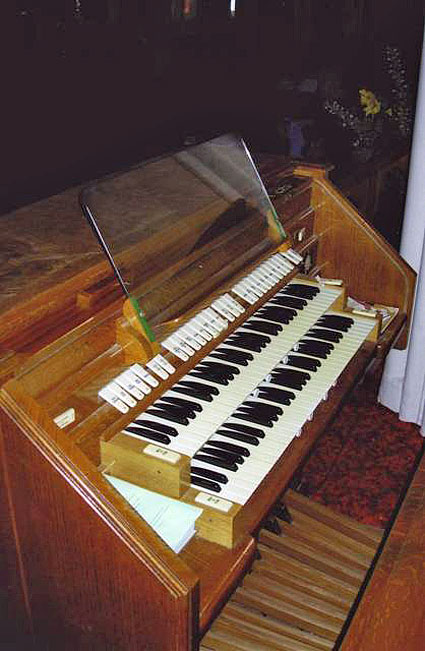
St Columb’s Anglican Church, Hawthorn: the 1954 console
[photograph by John Maidment (March 2021)]
The organ had been affected by water leakage, dust and falling plasterwork from the archway into the south transept. This affected the sound and performance of the organ. The keyboards were very noisy in operation owing to perished felts. The action to the swell shutters was primitive and non-functional and the power supply for the action required upgrading.
Comprehensive renovation work was carried out by Australian Pipe Organs Pty Ltd in 2021. It has included the following areas:
• Extensive cleaning of pipework, windchests and the tops of the three wind reservoirs
• Placement of a roof over the Great Organ to obviate dust falling from the tongue and groove boarded ceiling
• Strengthening of reed stays
• Pipework repairs
• Regulation of pipework and fine tuning
• Minor windchest repairs including releathering of pneumatic motors and pallets on the rear two chests for the Pedal Open Diapason affected by water ingress
• Installation of a new Petersen electro mechanical swell engine to replace the unsatisfactory 1954 four-stage concertina unit
• Installation of a new electric power supply regulator
• Refelting of the manual keyboards (and cleaning of surfaces) and pedal board – the latter has been recapped
• Upgrading of internal lighting
• Repair of the breakdown reservoir in the blowing chamber that had been affected by borer
• Provision of a new facsimile Roberts nameplate, mounted on the organ case, copied from that at All Saints’, East St Kilda
The pipe organ at St Columb’s Church, Hawthorn is significant for the following reasons:
• It retains its original tonal scheme of 1923 with a generous selection of romantic tone colours and Diapason choruses on each manual
• It is the most substantial example of its builder’s work that remains tonally intact
• It exhibits a generous approach to construction and incorporates imported metal pipework of excellent tonal quality
• The organ is very generously winded through multiple reservoirs, the main double-rise retaining its original feeders and feeding two single-rise reservoirs
• It is an important example of 1920s Australian organbuilding
• Most examples of Roberts’ major work have been altered by rebuilding or destroyed
• The Manchurian oak casework is distinctive and unusual, with its pointed towers and rare double-tiered flats
• No additions to the initial tonal scheme have been made
• The existence of a very rare double-mouth stopped wooden Doppel Flöte rank placed at the front of the Great windchest for optimum tonal projection. The only other example in Melbourne at the time would have been the example on the 1920 T.W. Magahy organ at the Church of Our Lady of Victories, Camberwell, nearby, which possibly inspired its inclusion and provided a model.
• It was designed by noted Melbourne organist A.E.H. Nickson FRCO and clearly emulates the tonal design and character of the 1912 Norman & Beard organ at St Peter's Church, Eastern Hill, where he was organist (in particular provision of the Swell Hohl Flute, Viol d’Orchestre and Lieblich Flute).
W.L. Roberts built two other major organs for Anglican churches in Melbourne at the time:
1923 St Andrew’s Anglican Church, Brighton (destroyed by fire 1961)
1924 All Saints’ Anglican Church, East St Kilda (rebuilt 1980, with new action, console and wind system, minor tonal changes, some revoicing and additions)
The instrument is classified by the National Trust of Australia (Victoria).
The current specification (unaltered from 1954) follows:
GREAT
Bourdon Open Diapason no 1 Open Diapason no 2 Doppel Flöte Dulciana Octave Harmonic Flute Fifteenth Trumpet Swell to Great Sub Swell to Great Swell to Great Super SWELL Open Diapason Hohl Flute Salicional Viol d’Orchestre Voix Celeste Principal Lieblich Flute Mixture Horn Oboe Swell Sub Octave Swell Super Octave Tremulant PEDAL Open Diapason Subbass Echo Bourdon Principal Bass Flute Great to Pedal Swell to Pedal |
8 8 8 8 4 4 2 8 16 8 8 8 8 8 4 4 III 8 8 16 16 16 8 8 |
A TC B C A B C |
Compass: 61/30
Electro-pneumatic action
Detached stopkey console
Adjustable pistons via switchboard
Balanced electro-mechanical swell pedal
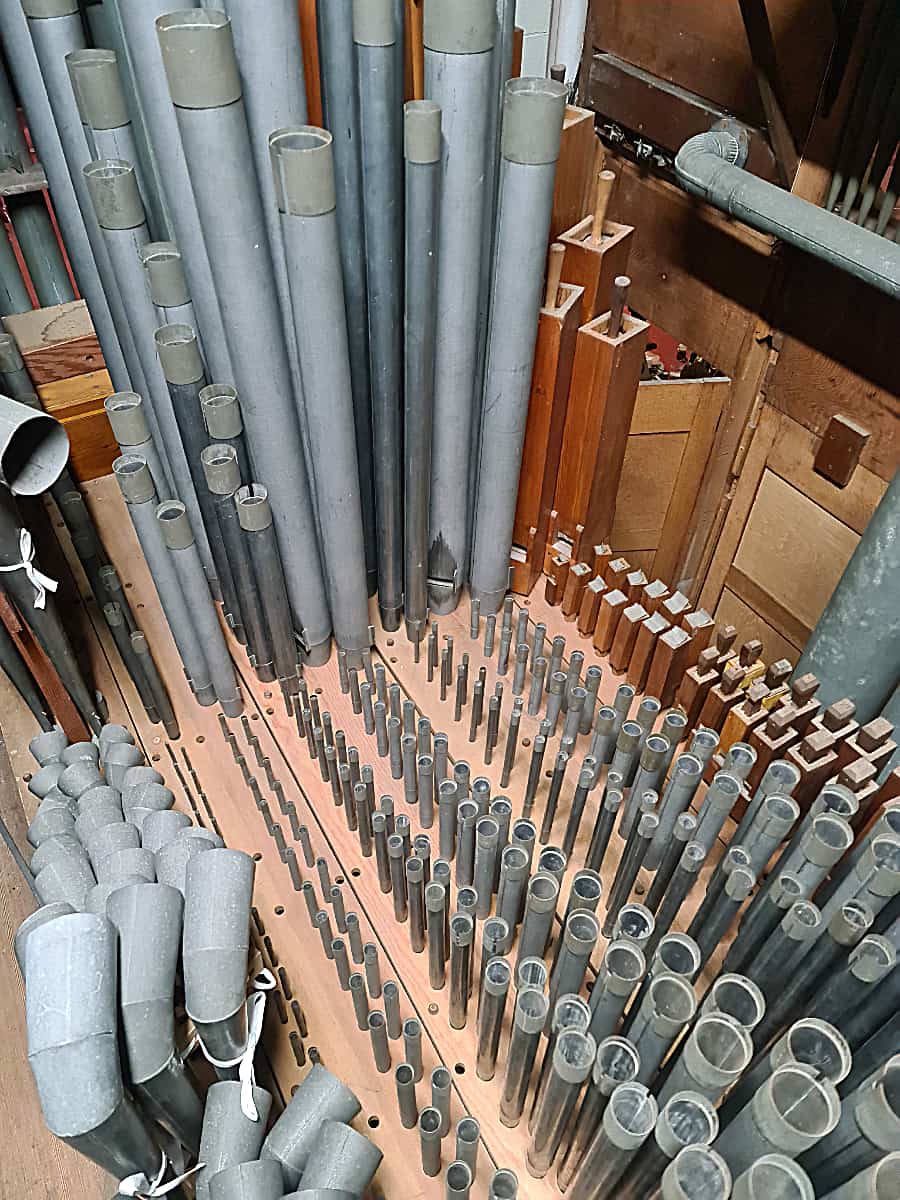
St Columb’s Church, Hawthorn: Great windchest and pipework
[photograph by Daniel Bittner (October 2021)]
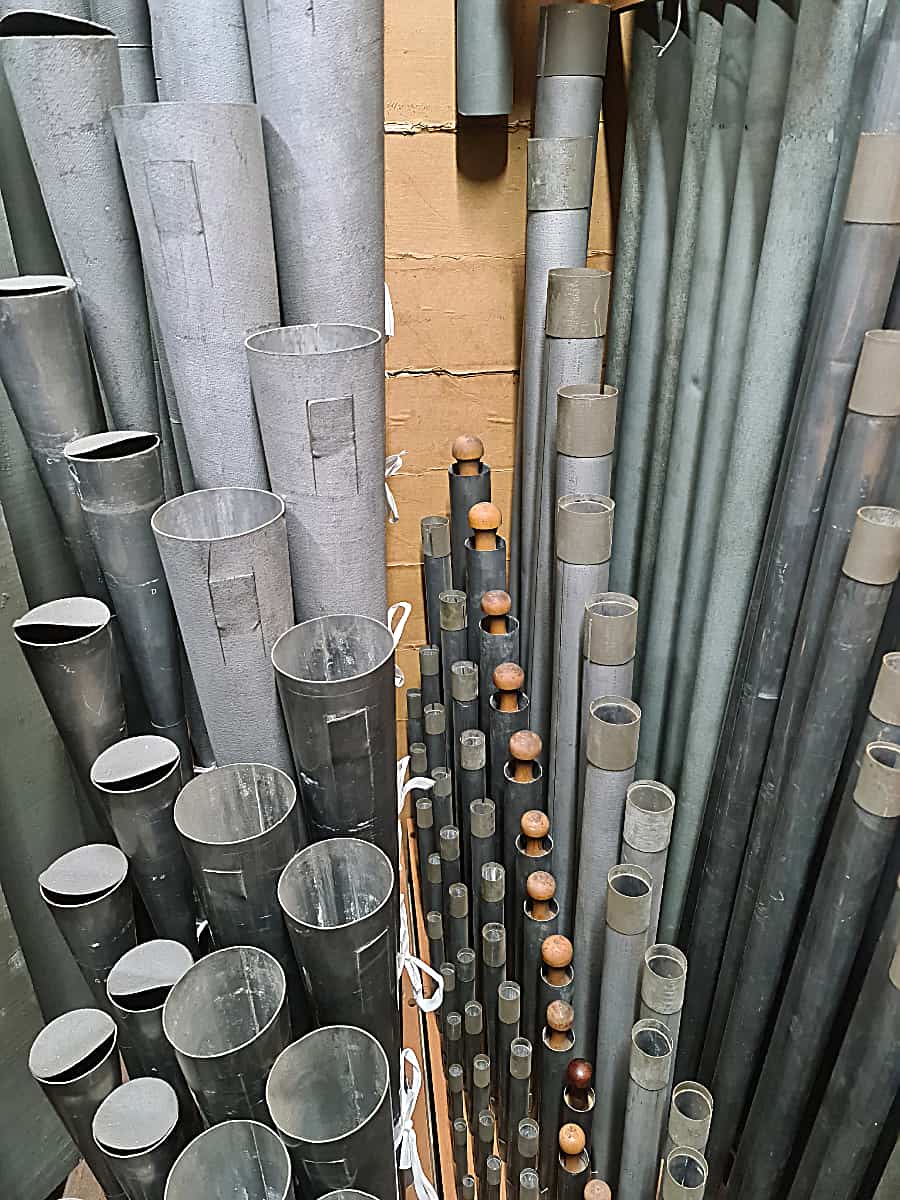
St Columb’s Church, Hawthorn: Swell windchest and pipework
[photograph by Daniel Bittner (October 2021)]
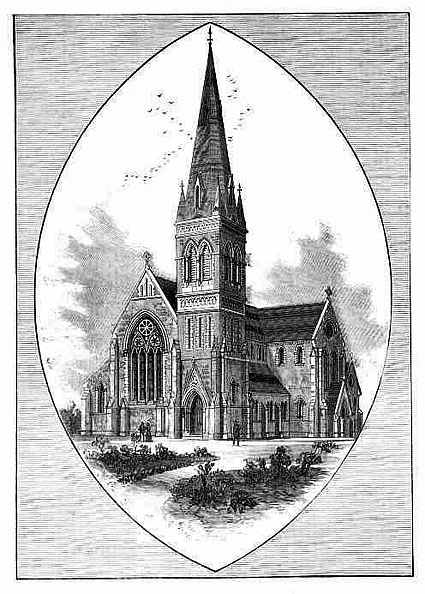
St Columb’s Church shown in its completed state with the intended tower and spire
[National Trust of Australia (Victoria)]
1 Victorian Churches: their origins, their story & their architecture, edited by Miles Lewis. Melbourne: National Trust of Australia (Victoria), 1991, p.72.
2 Church of England Messenger, 10 December 1884
3 Information from the Roberts archive kindly supplied by David Shield, including Roberts Ltd order list, organ pamphlet, press cuttings and certificate of approval.
4 The Argus, 1 October 1923